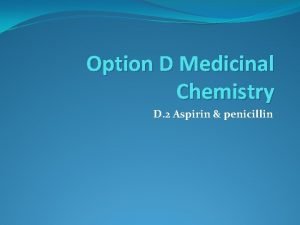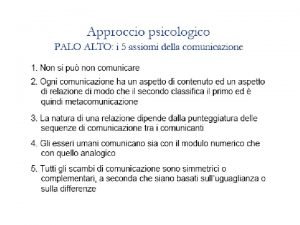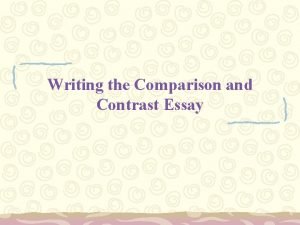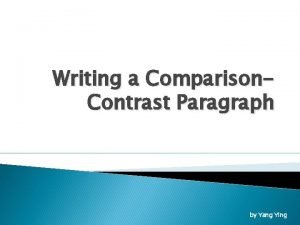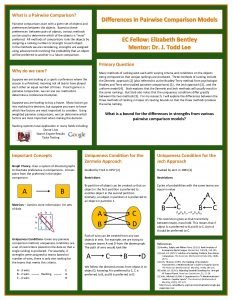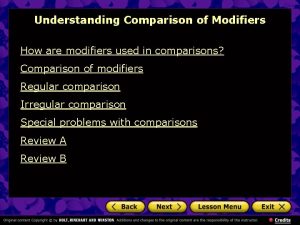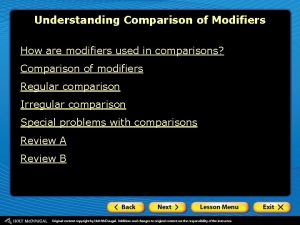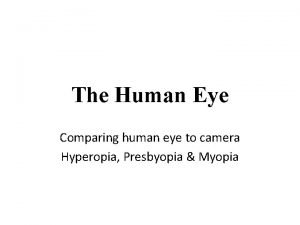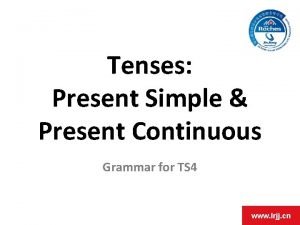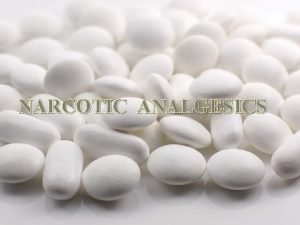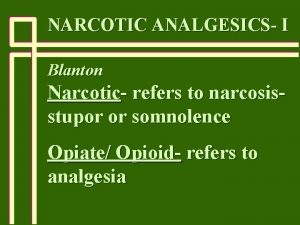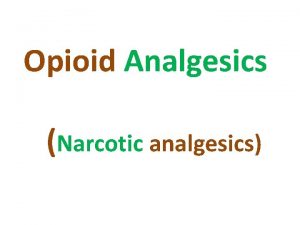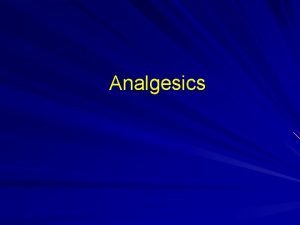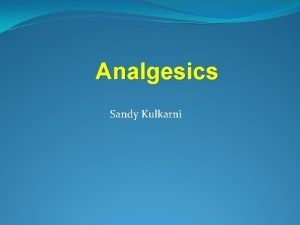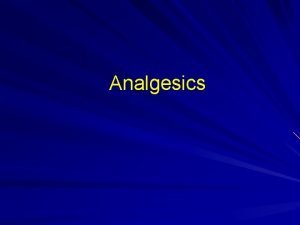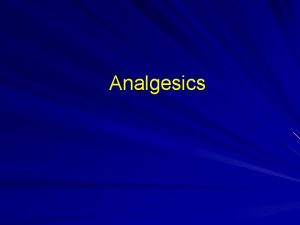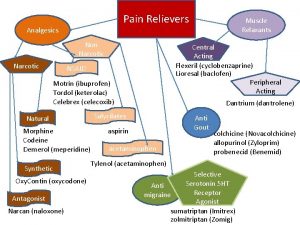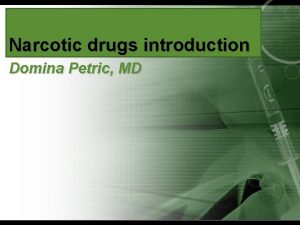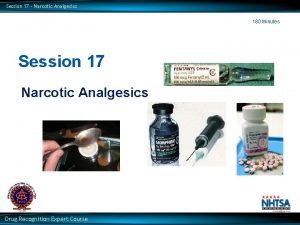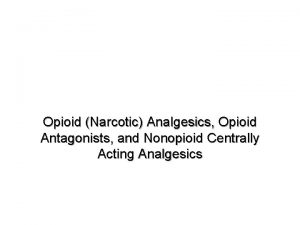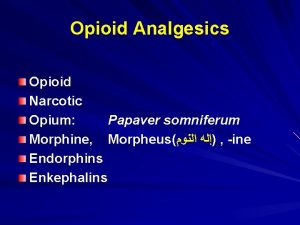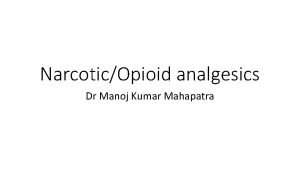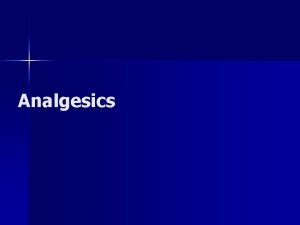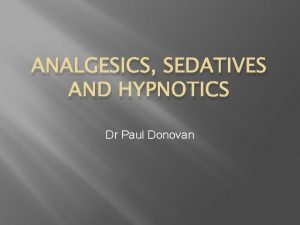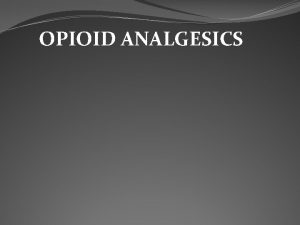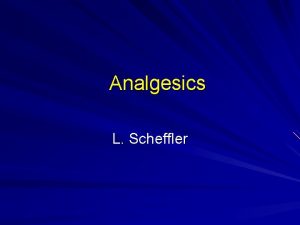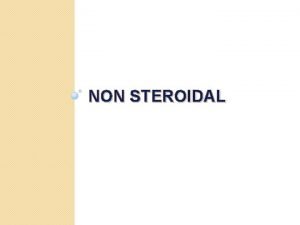Analgesics Narcotic Analgesics Non Narcotic Analgesics Comparison of














































- Slides: 46

Analgesics Narcotic Analgesics. Non Narcotic Analgesics


Comparison of Analgesics Feature Narcotic (Opioids) Nonnarcotic (nonopioid) Efficacy Strong Weak Prototype Morphine Aspirin Pain Relieved Any Type Musculoskeletal Site of Action Central Peripheral and Central Mechanism Specific Receptors PG Synthesis Danger Tolerance & Dependence G. I irritation Anti-inflammatory No Yes Antipyretic No Yes Antiplatelets No Yes

Non Narcotic Analgesics Non Steroidal Antiinflammatory Drugs or Agents (NSAID). Non Opioid analgesics.

NSAID Mechanism of Action: n Inhibition of PG synthesis – Cyclooxygenase (COX) Enzyme. – Two types of COX enzyme: § COX-1 present in all parts of the body. § COX-2 locally induced by inflammation.

Pharmacological Actions of NSAID n Analgesic. n Antipyretic n Anticoagulant. n Antiinflammatory.

Pharmacological Actions of NSAID n n n Fluid Retention Vasodilation Allergenic: – Bronchial Asthma. – Anaphylaxis

Pharmacological Actions of NSAID n Gastric Irritation: Direct Irritation: if acidic. PG inhibition: all Variable response : according to: Individual, Dose, Agent, Severity.

Pharmacological Actions of NSAID n Hepatic Dysfunction: – Especially with acetaminophen overdose. n Renal Dysfunction: Analgesic Nephropathy. n Uterine relaxation, can delay labor.

Salicylates n Weak acids: p. Ka 3. 5 n Protein Bound. n Distribute to all tissues n Elimination: – High doses: – Low doses: Zero Order First Order

ADRs & Overdose of Salicylates n Hyperventilation n Metabolic Acidosis n Hypersensitivity: Salicylism n Reye's Syndrome, in children. n Bleeding n Delays delivery n Fetal Abnormalities n Ulcerogenic

Acetaminophen = Paracetamol n Less plasma protein bound n Weak PG synthesis inhibitor n Actions may be through CNS activity.

Acetaminophen = Paracetamol Very commonly used analgesic, effective, safe, and cheap. n Not: n – – Antiinflammatory Platelets inhibitor Ulcerogenic Teratogenic

Acetaminophen = Paracetamol n Toxicity – Severe hepatotoxicity, only with high doses. Evident only after 24 hours of ingestion. – N- acetylcysteine is the antidote, should be given in the first 24 hours.

Diclofenac – Potent, widely used. – Available for oral, local( ophthalmic, topical gel), mouth wash, rectal and parenteral administration( for renal colic).

Propionic Acid Derivatives n Ibuprofen n Ketoprofen n Naproxin

Older Analgesics n Indomethacin – Pancytopenia n Phenylbutazone – Aplastic Anemia n Mefenamic Acid


Cyclooxygenase II Inhibitors n Meloxicam n Rofecoxib n Celocoxib

Cyclooxygenase II Inhibitors n Selective for COX at inflammation sites. n Do not affect platelet function. n May increase the incidence of edema and hypertension. n Less gastroirritant. n Higher incidence of cardiovascular thrombotic events.

Opioid Analgesics Opioid Narcotic Opium: Papaver somniferum Morphine, Morpheus( )ﺇﻟﻪ ﺍﻟﻨﻮﻡ , -ine Endorphins Enkephalins

Opioid Analgesics Dependence = ( ﺇﻋﺘﻤﺎﺩ Abuse , Addiction , Habituation): Psychological (Psychic, Craving , Compulsive) Physiological (Physical , Adaptive. . . ) Tolerance= ﺗﺤﻤﻞ. Cross Dependence. Cross Tolerance.

History of Opium Papaver semniferum Morphine Heroin ﺷﺮﻛﺔ ﺍﻟﻬﻨﺪ ﺍﻟﺸﺮﻗﻴﺔ ﺣﺮﺏ ﺍﻷﻔﻴﻮﻥ ﺍﺧﺘﺮﺍﻉ ﺍﻟﺴﻴﺮﻧﺞ Morphine Receptors 3000 BC 1806 1898 1600 1839 -1842 1853 1973

Opioid Receptors Mu 1 Mu 2 Kappa Sigma Delta Epsilon. – Agents differ in their affinity and selectivity to these receptors. – This will produce different pharmacological actions.

Opiate Receptor Interactions

Depressant effects of Morphine Analgesia, suppression of pain. Drowsiness and decreased mental alertness, sedation Decreased respiration. Increased intracranial pressure. Decreased myocardial oxygen demand. Suppression of cough, antitussive.

Depressant effects of Morphine Decreased peristalsis. Inhibition of fluid and electrolyte accumulation in the intestinal lumen. Decreased gastric acid secretion. Slight decrease in body temperature. Decreased release of LH and FSH

Stimulant effects of Morphine Euphoria. Miosis, constriction of pupils. Stimulation of chemoreceptor trigger zone. Increased tone of intestinal smooth muscle. Increased tone of sphincter of Oddi, so, increased biliary pressure.

Stimulant effects of Morphine Increased tone of detrusor muscle. Increased tone of vesical sphincter. Increased release of prolactin and antidiuretic hormone. Proconvulsant in overdose.

Pharmacokinetics Highly lipid soluble, so easily absorbed and widely distributed. Metabolized in the liver. Great first-pass effect(75%).

Therapeutic Uses Severe Acute pain of temporary nature. Chronic Pain: Pain of terminal cancer Try nonopiates first. Try weaker opiates first. Use regular fixed schedule. Obstetric Anesthesia. Preanesthetic medication. Pulmonary Edema: Relieve anxiety. Cause peripheral blood pooling Severe diarrhea and dry cough.

Adverse Effects Bradycardia. Urinary retention. Dry mouth, nausea, vomiting. Allergic reactions. Constipation. Sedation, confusion, nightmares, hallucinations. Dependence and withdrawal reactions. Respiratory depression and death.

Diagnostic Sign of Toxicity Pinpoint pupils …. . No tolerance

Contraindications Head Injury. Shock and decreased blood volume. Chronic hypoxic conditions.

Tolerance to Opioids Tolerance develops to almost all actions of opioids, EXCEPT: Miosis( diagnostic sign of overdose and tolerance). Constipation. Convulsions.

Tolerance to Opioids Tolerance to opioids is homeostatic. Factors Affecting Development of Tolerance: Rate of Administration Dose Agent used.

Agent Analgesia Antitussive Constipation Respiratory Abuse Liability Depression Morphine +++ +++ +++ Heroin +++ +++ ++++ Codeine + ++ ++ + +, - Oxycodone ++ ++ +++ Meperidine ++ ___ +, - +++ ++ Methadone +++ ++ D-propoxyphene + __ +, - + +

Homeostatic Mechanism of Tolerance.

Opioid Withdrawal 6 -12 hr: Drug seeking (purposive) behavior, non purposive signs, such as restlessness, lacrimation, rhinorrhea, sweating, yawning. 12 -24 hr: Restless sleep for several hours (yen) and feeling more miserable than before after awakening; irritability, tremor, dilated pupils, anorexia, gooseflesh skin.

Opioid Withdrawal 24 -72 hr: Increased intensity of previous signs plus weakness, depression, nausea, vomiting, intestinal cramps, diarrhea, alternate chills and flushes, various aches and pains, increased heart rate and blood pressure, involuntary movements of arms and legs, dehydration and possible electrolyte imbalances.

Opioid Withdrawal Later: Above symptoms of autonomic hyperactivity alternate with brief periods of restless sleep and gradually decrease in intensity until addict feels better in 7 -10 days but may still exhibit strong craving for the drug. Some mild signs may be detectable for up to 6 months. Delayed growth and development of infants born to addicted mothers may be detected for up to one year.

Treatment of Opioid Dependence Suppression of Withdrawal Syndrome Morphine Heroin Opioid Substitution: Methadone Detoxification: Gradually decreasing the dose of methadone. Naloxone Narcotic Antagonists: Naltrexone for 2 -6 months following detoxification.

Opioid Agonists Morphine – Prototype. Codeine: – Mild analgesic(1/7 th of morphine) Heroin: – 6 -acyl morphine, modified morphine. – More potent, very lipid soluble, enters CNS very rapidly.

Opioid Agonists Meperidine (Pethidine): – – – Less powerful than morphine. Less dependence. Less effect on cough and respiratory center. Can be used in head injury. Was widely used for labor, but replaced by epidural analgesia. – Action lasts for 2 -3 hours. – Can be given orally, sc, im, iv. Methadone & L Acetyl Methadone (LAAM): – Same as morphine but has little of morphine’s euphoria. – Can substitute for morphine in the treatment of withdrawal reactions.

Opioid Agonists d- Propoxyphene: – Weak analgesic. – Usually combined with paracetamole. – Slightly addictive. Fentanyl: – – – Short acting. Used IV for anesthetic induction. Also used as a patch for terminal pain. Tramadol: – – – New analgesic. As powerful as meperidine. Action extends for 6 hours. Given orally and parenterally. Addiction potential is low.

Opioid Antagonists Naloxone: – No analgesic action. – Used for morphine poisoning. – Rapid and short action. – So, repeated doses may be needed. Naltrexone: – Longer acting. – Used for treatment of dependence.
 Mechanism of action of opioid analgesics
Mechanism of action of opioid analgesics Classification of analgesic
Classification of analgesic Analgesics examples
Analgesics examples Pourquoi ne pas chanter la gloire du seigneur lyrics
Pourquoi ne pas chanter la gloire du seigneur lyrics Direct comparison test
Direct comparison test Non nobis domine, non nobis, sed nomini tuo ad gloriam
Non nobis domine, non nobis, sed nomini tuo ad gloriam Bene non escludibile e non rivale
Bene non escludibile e non rivale Non-rivalry
Non-rivalry Mengapa tuhan menciptakan manusia menurut gambarnya
Mengapa tuhan menciptakan manusia menurut gambarnya Non fare mai quello che non vorresti sia fatto a te
Non fare mai quello che non vorresti sia fatto a te Contoh pelarut anorganik
Contoh pelarut anorganik Chi non stima la vita non la merita
Chi non stima la vita non la merita Non nobis domine non nobis sed nomini tuo da gloriam
Non nobis domine non nobis sed nomini tuo da gloriam Canto 27 inferno
Canto 27 inferno In kennedy theory the value of constant c for coarse silt
In kennedy theory the value of constant c for coarse silt Non fidarti di chi non chiude gli occhi quando ti bacia
Non fidarti di chi non chiude gli occhi quando ti bacia Humanistic-aesthetic approach
Humanistic-aesthetic approach Non mihi non tibi sed nobis
Non mihi non tibi sed nobis No gyro approach
No gyro approach Quia non sunt
Quia non sunt Gli assiomi della comunicazione
Gli assiomi della comunicazione Lên non mới biết non cao lội sông mới biết
Lên non mới biết non cao lội sông mới biết Comparison and contrast outline
Comparison and contrast outline Comparison contrast paragraph
Comparison contrast paragraph Pairwise comparison
Pairwise comparison Dra comparison chart
Dra comparison chart Joomla vs plone
Joomla vs plone Conservancy system
Conservancy system Comparison clue meaning
Comparison clue meaning Origins of vc and datagram networks
Origins of vc and datagram networks Romeo and juliet west side story comparison chart
Romeo and juliet west side story comparison chart Degrees of comparison for dry
Degrees of comparison for dry Pengecualian degree of comparison
Pengecualian degree of comparison Uninformed search algorithm
Uninformed search algorithm Inter firm comparison
Inter firm comparison Comparative modifiers
Comparative modifiers Modifiers with comparatives
Modifiers with comparatives Coverdell vs 529 comparison chart
Coverdell vs 529 comparison chart Imaginative comparison examples
Imaginative comparison examples Power of nature in kamikaze
Power of nature in kamikaze Great lakes depth comparison
Great lakes depth comparison Eye camera comparison
Eye camera comparison The emigree by carol rumens
The emigree by carol rumens Similarities and contrast
Similarities and contrast Introduction to comparative essay
Introduction to comparative essay Compare words
Compare words Present simple of be
Present simple of be

